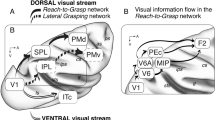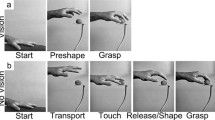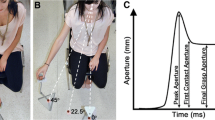Abstract
Dual visuomotor channel theory proposes that reaching depends on two neural pathways that extend from visual cortex (V1) to motor cortex via the parietal lobe. The Reach pathway directs the hand to the target’s location and the Grasp pathway shapes the hand and digits for purchase. Sighted human participants integrate the Reach and the Grasp, but without vision they dissociate the movements to capitalize on tactile cues. They use a Reach with a relatively open hand to locate the target and then they use touch cues to shape the fingers to Grasp. After a V1 lesion, the rhesus monkey, Helen, learned to make near-normal visual discriminations based on size and brightness but displayed visual agnosia. She also learned to reach for food with her mouth and her hands. The present analysis of film of her reaching behavior shows that she dissociated the Reach and the Grasp, as do unsighted human participants reaching for a food target at a fixed location. Her rapid and direct Reach was made with an open hand and extended fingers to contact the food with the palm whereas her Grasp was initiated after she touched the food. She also visually fixated the target during the Reach and visually disengaged after target contact, as do sighted human participants. In contrast, Helen did integrate the Reach and the Grasp to take food from her mouth, demonstrating that she could integrate the movements using online tactile cues. The finding that extrastriate pathways can direct the hand toward extrinsic target properties (location) but not intrinsic target properties (size and shape) is discussed as a novel addition to dual visuomotor channel theory.








Similar content being viewed by others
References
Binkofski F, Dohle C, Posse S, Stephan KM, Hefter H, Seitz RJ, Freund HJ (1998) Human anterior intraparietal area subserves prehension: a combined lesion and functional MRI activation study. Neurology 50:1253–1259. doi:10.1212/WNL.50.5.1253
Caminiti R, Chafee MV, Battaglia-Mayer A, Averbeck BB, Crowe DA, Georgopoulos AP (2010) Understanding the parietal lobe syndrome from a neurophysiological and evolutionary perspective. Eur J Neurosci 31:2320–2340. doi:10.1111/j.1460-9568.2010.07291.x
Cavina-Pratesi C, Monaco S, Fattori P, Galletti C, McAdam TD, Quinlan DJ, Goodale MA, Culham JC (2010a) Functional magnetic resonance imaging reveals the neural substrates of arm transport and grip formation in Reach-to-Grasp actions in humans. J Neurosci 30:10306–10323. doi:10.1523/JNEUROSCI.2023-10.2010
Cavina-Pratesi C, Ietswaart M, Humphreys GW, Lestou V, Milner AD (2010b) Impaired grasping in a patient with optic ataxia: primary visuomotor deficit or secondary consequence of misreaching? Neuropsychologia 48:226–234. doi:10.1016/j.neuropsychologia.2009.09.008
Cowey A (1974) Atrophy of retinal ganglion cells after removal of striate cortex in a rhesus monkey. Perception 3:257–260. doi:10.1068/p030257
Culham JC, Valyear KF (2006) Human parietal cortex in action. Curr Opin Neurobiol 16:205–212. doi:10.1016/j.conb.2006.03.005
Darling WG, Morecraft RJ, Rotella DL, Pizzimenti MA, Ge J, Stilwell-Morecraft KS, Zhang H, Soliman H, Seecharan D, Edwards I, McNeal D, Nudo RJ, Cheney P (2014) Recovery of precision grasping after motor cortex lesion does not require forced use of the impaired hand in Macaca mulatta. Exp Brain Res 232:3929–3938. doi:10.1007/s00221-014-4068-9
de Bruin N, Sacrey LA, Brown LA, Doan J, Whishaw IQ (2008) Visual guidance for hand advance but not hand withdrawal in a reach-to-eat task in adult humans: reaching is a composite movement. J Mot Behav 40:337–346. doi:10.3200/JMBR.40.4.337-346
Ferrari-Toniolo S, Visco-Comandini F, Papazachariadis O, Caminiti R, Battaglia-Mayer A (2015) Posterior parietal cortex encoding of dynamic hand force underlying hand-object interaction. J Neurosci 35:10899–10910. doi:10.1523/JNEUROSCI.4696-14.2015
Foroud A, Whishaw IQ (2012) The consummatory origins of visually guided reaching in human infants: a dynamic integration of whole-body and upper-limg movements. Behav Br Res 23:343–355
Frak V, Paulignan Y, Jeannerod M, Michel F, Cohen H (2006) Prehension movements in a patient (AC) with posterior parietal cortex damage and posterior callosal section. Brain Cogn 60:43–48. doi:10.1016/j.bandc.2005.09.010
Gentilucci M, Benuzzi F, Gangitano M, Grimaldi S (2001) Grasp with hand and mouth: a kinematic study on healthy subjects. J Neurophysiol 86:1685–1699
Girard P (1991) Visual activity in visual area V3A and V3 after reversible inactivation of area V1 in the rhesus monkey. J Neurophysiol 66:1493–1503
Graziano MSA, Taylor CSR, Moore T (2002) Complex movements evoked by microstimulation of precentral cortex. Neuron 34:841–851. doi:10.1016/S0896-6273(02)00698-0
Hall LA, Karl JM, Thomas BL, Whishaw IQ (2014) Reach and Grasp reconfigurations reveal that proprioception assists reaching and hapsis assists grasping in peripheral vision. Exp Brain Res 232:2807–2819. doi:10.1007/s00221-014-3945-6
Humphrey NK (1970) What the frog’s eye tells the monkey’s brain. Brain Behav Evol 3:324–327
Humphrey NK (1973) Predispositions to learn. In: Hind RA, Stephenson-Hinde J (eds) Constraints on learning. Academic Press, London pp 301–304
Humphrey NK (1974) Vision in a monkey without striate cortex: a case study. Perception 3:241–255. doi:10.1068/p030241
Humphrey NK, Weiskrantz L (1967) Vision in monkeys after removal of the striate cortex. Nature 215:595–597. doi:10.1038/215595a0
Ivanco TL, Pellis SM, Whishaw IQ (1996) Skilled forelimb movements in prey catching and in reaching by rats (Rattus norvegicus) and opossums (Monodelphis domestica): relations to antomical differences in motor systems. Behav Brain Res 79:163–181. doi:10.1016/j.bbr.2004.01.028
Jeannerod M (1981) Intersegmental coordination during reaching at natural visual objects. In: Long J, Badeley A (eds) Attention and performance IX. Lawrence Erlbaum Associates, Hillsdale, pp 152–169
Jeannerod M (1986) The formation of finger grip during prehension. A cortically mediated visuomotor pattern. Behav Brain Res 19:99–116
Jeannerod M, Decety J, Michal F (1994) Impairment of grasping movements following bilateral posterior parietal lesion. Neuropsychologia 32:369–380. doi:10.1016/0028-3932(94)90084-1
Kaas JH, Stepniewska I, Gharbawie O (2012) Cortical networks subserving upper limb movements in primates. Eur J Phys Rehabil Med 48:299–306
Karl JM, Whishaw (2013) Different evolutionary origins for the Reach and the Grasp: an explanation for dual visuomotor channels in primate parietofrontal cortex. Front Neurol. doi:10.3389/fneur.2013.00208
Karl JM, Whishaw IQ (2014) Haptic grasping configurations in early infancy reveal different developmental profiles for visual guidance of the Reach versus the Grasp. Exp Brain Res 232:3301–3316. doi:10.1007/s00221-014-4013-y
Karl JM, Sacrey LA, Doan JB, Whishaw IQ (2012a) Hand shaping using hapsis resembles visually guided hand shaping. Exp Brain Res 219:59–74. doi:10.1007/s00221-012-3067-y
Karl JM, Sacrey LA, Doan JB, Whishaw IQ (2012b) Oral hapsis guides accurate hand preshaping for grasping food targets in the mouth. Exp Brain Res 221:223–240. doi:10.1007/s00221-012-3164-y
Karl JM, Schneider LR, Whishaw IQ (2013) Nonvisual learning of intrinsic object properties in a reaching task dissociates Grasp from reach. Exp Brain Res 225:465–477. doi:10.1007/s00221-012-3386-z
Krauker J, Ghez C (2000) Voluntary movement. In: Kandel ER, Schwartz JH, Jessell TM (eds) Principles of neural science, 4th edn. McGraw Hill, New York
Lyon DC, Nassi JJ, Callaway EM (2010) A disynaptic relay from superior colliculus to dorsal stream visual cortex in macaque monkey. Neuron 65:270–279. doi:10.1016/j.neuron.2010.01.003
Milner AD, Goodale MA (2006) The visual brain in action. Oxford University Press, Oxford
Milner AD, Paulignan Y, Dijkerman HC, Michel F, Jeannerod M (1999) A paradoxical improvement of misreaching in optic ataxia: new evidence for two separate neural systems for visual localization. Proc Biol Sci 266:2225–2229. doi:10.1098/rspb.1999.0912
Perenin MT, Rossetti Y (1996) Grasping without form discrimination in a hemianopic field. Neuroreport 7(3):793–797
Philipp R, Hoffmann HP (2014) Arm movements induced by electrical microstimulation in the superior colliculus of the macaque monkey. J Neurosci 34(9):3350–3363. doi:10.1523/JNEUROSCI.0443-13.2014
Reyes-Puerta V, Philipp R, Lindner W, Hoffmann KP (2010) Role of the rostral superior colliculus in gaze anchoring during reach movements. J Neurophysiol 103:3153–3166. doi:10.1152/jn.00989.2009
Sacrey LA, Whishaw IQ (2012) Subsystems of sensory attention for skilled reaching: vision for transport and pre-shaping and somatosensation for grasping, withdrawal and release. Behav Brain Res 231:356–365. doi:10.1016/j.bbr.2011.07.031
Sacrey LA, Alaverdashvili M, Whishaw IQ (2009) Similar hand shaping in reach-for-food (skilled reaching) in rats and humans provides evidence of homology in release, collection, and manipulation movements. Behav Brain Res 204:153–161. doi:10.1016/j.bbr.2009.05.035
Saling M, Mescheriakov S, Molokanova E, Stelmach GE, Berger M (1996) Grip reorganization during wrist transport: the influence of an altered aperture. Exp Brain Res 108:493–500. doi:10.1007/BF00227272
Sivak B, MacKenzie CL (1990) Integration of visual information and motor output in reaching and grasping: the contributions of peripheral and central vision. Neuropsychologia 28:1095–1116. doi:10.1016/0028-3932(90)90143-C
Solomon SJ, Pasik T, Pasik P (1981) Extrageniculostriate vision in the monkey VIII. Critical structures for spatial localization. Exp Brain Res 44:259–270
Song JH, McPeek RM (2015) Neural correlates of target selection for reaching movements in superior colliculus. J Neurophysiol 113:1414–1422. doi:10.1152/jn.00417.2014
Standage GP, Benevento LA (1983) The organization of connections between the pulvinar and visual area MT in the macaque monkey. Brain Res 262:288–294. doi:10.1016/0006-8993(83)91020-X
Stepniewska I, Gharbawie OA, Burish MJ, Kaas JH (2014) Effects of muscimol inactivations of functional domains in motor, premotor, and posterior parietal cortex on complex movements evoked by electrical stimulation. J Neurophysiol 111:1100–1119. doi:10.1152/jn.00491.2013
Vilensky JA, Morecraft RJ, Gilman S, Cook JA (1998) "Mouth-feeding" in monkeys after sensorimotor system lesions: an analysis based on the Denny-Brown collection. Behav Br Res 94:311–315
Vesia M, Crawford DJ (2012) Specialization of reach function in human posterior parietal cortex. Exp Brain Res 221:1–18. doi:10.1007/s00221-012-3158-9
Vesia M, Bolton DA, Mochizuki G, Staines WR (2013) Human parietal and primary motor cortical interactions are selectively modulated during the transport and grip formation of goal-directed hand actions. Neuropsychologia 51:410–417. doi:10.1016/j.neuropsychologia.2012.11.022
Werner W, Dannenberg S, Hoffmann KP (1997) Arm-movement-related neurons in the primate superior colliculus and underlying reticular formation: comparison of neuronal activity with EMGs of muscles of the shoulder, arm, and trunk during reaching. Exp Brain Res 115:191–205. doi:10.1007/PL00005690
Whishaw IQ and Darling WG (2016) Impaired integration of the Reach and Grasp after motor cortex (M1) hand area lesion in Macaca mulatta: support for dual visuomotor theory of reaching, unpublished manuscript
Whishaw IQ, Karl JM (2014) The contribution of the Reach and the Grasp to shaping brain and behaviour. Can J Exp Psychol 68:223–235. doi:10.1037/cep0000042
Whishaw IQ, Travis SG, Koppe SW, Sacrey LA, Gholamrezaei G, Gorny B (2010a) Hand shaping in the rat: conserved release and collection versus flexible manipulation in overground walking, ladder rung walking, cylinder exploration, and skilled reaching. Behav Brain Res 206:21–31. doi:10.1016/j.bbr.2009.08.030
Whishaw IQ, Sacrey LA, Travis SG, Gholamrezaei G, Karl JM (2010b) The functional origins of speech-related hand gestures. Behav Brain Res 214:206–215. doi:10.1016/j.bbr.2010.05.026
Whitwell RL, Striemer CL, Nicolle DA, Goodale MA (2011) Grasping the non-conscious: preserved grip scaling to unseen objects for immediate but not delayed grasping following a unilateral lesion to primary visual cortex. Vis Res 51:908–924
Wong YJ, Whishaw IQ (2004) Precision Grasps of children and young and old adults: individual differences in digit contact strategy, purchase pattern, and digit posture. Behav Brain Res 154:113–123. doi:10.1016/j.bbr.2004.01.028
Author information
Authors and Affiliations
Corresponding author
Electronic supplementary material
Below is the link to the electronic supplementary material.
Supplementary material 2 (MP4 141394 kb)
Rights and permissions
About this article
Cite this article
Whishaw, I.Q., Karl, J.M. & Humphrey, N.K. Dissociation of the Reach and the Grasp in the destriate (V1) monkey Helen: a new anatomy for the dual visuomotor channel theory of reaching. Exp Brain Res 234, 2351–2362 (2016). https://doi.org/10.1007/s00221-016-4640-6
Received:
Accepted:
Published:
Issue Date:
DOI: https://doi.org/10.1007/s00221-016-4640-6




